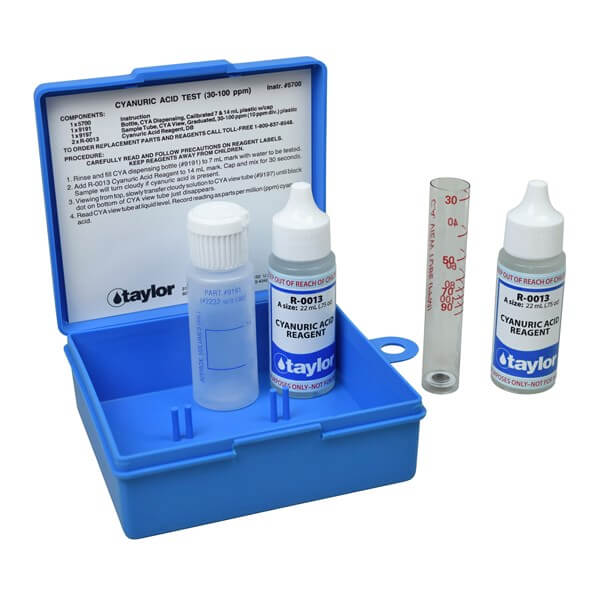Starting about a year ago, Rudy Stankowitz reported that he had found that using alum (aluminum sulfate) could remove CYA from pool water but that more testing was needed before widely using this method.
There are some questions and observations I have about using alum (aluminum sulfate) for CYA reduction or removal. I am not saying it does not work. I am offering some alternative conclusions and explanations. More evidence is needed.
No Scientific Literature
There is no evidence in the scientific literature anywhere that states alum (aluminum sulfate) can be used for lowering or removing CYA. This does not mean that it cannot be used for CYA reduction or that it does not work for that purpose. It only means that no one has documented or studied alum for CYA removal and published their work.
Alum Chemistry and Use
Alum is used in drinking water treatment, waste-water treatment, swimming pools, and other industries. In water treatment, it causes suspended impurities to coagulate into larger particles and then settle to the bottom of the vessel (or be filtered out) more easily. This process is called coagulation or flocculation. When dissolved in a large amount of neutral or slightly acidic water, aluminum sulfate produces a gelatinous precipitate of aluminum hydroxide – Al(OH)3. The precipitate is called floc. The floc forms better when the pH is from 6.5 to 7.0. The gelatinous floc attracts and holds on to suspended particles in the water and settles to the bottom where it can be vacuumed or be drawn into the main drain.
Alum is used to coagulate suspended, negatively charged particles to make them larger and more conducive to filtration or sedimentation. The keywords here are suspended negatively charged particles.
In pool water, CYA is dissolved and not suspended. At typical pool water pH, CYA exists predominantly as the mono-an- ion (H2C3N3O3)–. It can exist as five other species but about 94% is the mono-anion.
Alum-CYA Removal Method
The Alum-CYA Removal method calls for lowering pH to 6.8 to 7.0, adding a dose of alum of 8.3 lbs per 10,000 gallons of pool water, mixing until the floc forms and settles to the bottom, and vacuuming to waste about 12 to 14 hours later.
This dose is about double the recommended dose of alum as a coagulant for mildly cloudy pool water. Adding alum to a pool that is not cloudy or turbid means that the alum can remain in the water for some time with no suspended particles to remove and a double dose has been added.
 CYA Testing
CYA Testing
The CYA test is turbidimetric (or cloudiness). The turbidity is due to the formation of an insoluble melamine-cyanurate precipitate when the reagent melamine is added to pool water containing CYA. One usually reads a black spot through the turbidity or even in some electronic equipment, a beam of light at a special wavelength is passed through a sample cell to determine the concentration of CYA.
Alum May Be Affecting the Test
Due to the high dose of alum to the pool water, low or no turbidity in the water, and a relatively short time until CYA may be tested (12 hours later), there may be some active alum in the pool water. Alum can remain active in the water for about 48 hours or longer if there is low turbidity or nothing for it to remove. When alum is present in the pool water along with CYA, the alum will coagulate the melamine-cyanurate precipitate reducing the turbidity just like it does in a cloudy pool. Reducing the turbidity in the sample will appear as an “apparent” reduced amount of CYA present. This is further evidenced by reports that alum has reduced CYA by a percentage instead of a ppm reduction. I see people writing saying that they lowered CYA by some percent. Usually, this is about 50 percent. They do not say that alum was reduced by a ppm. If alum was truly working as a removal method, then we would expect a reduction of some ppm per some dose of alum. Instead, we are hearing about reducing CYA by some percent.
Anecdotal Reports Say CYA Lowered then Increased
Then we hear about pools that have “lowered” CYA by this method and sometime later the CYA has gone back up. They conclude that CYA was absorbed in the plaster, plumbing, filter, or other equipment and now it is redissolving or releasing back into the pool water. Another explanation might be that there was alum in the sample when the CYA test was performed only 12 hours after adding a double dose to water that was not cloudy. The alum clarified the sample as the melamine-CYA turbidity was produced and gave a lower reading. Weeks later when all the alum in the pool water is gone, a CYA test now shows a higher CYA concentration even though no more CYA was added. The alternative explanation is that now that there is no more alum in the pool water, you now are getting an accurate CYA test result. This indicates that the alum may have clarified the initial CYA test giving a false reading.
Just an Alternative Explanation
My logic, science-based conclusions are exactly that until proven or disproved. I cannot cite any direct articles or evidence. It is a possible explanation for the apparent reduction in CYA due to an alum dose. It is the reason that I am skeptical. Perhaps more testing and even revisiting some pools with success might show an increase in CYA after a few weeks. I have plenty of reports that say that alum removes CYA and plenty of reports that say that CYA goes back up a week or two later. I want to prove that this works before we all start recommending it only to find out that it doesn’t.
Is CYA Absorbed or Embedded into the Plaster?
The idea that CYA gets embedded or absorbed into the plaster is another phenomenon that needs to be investigated. We hear all the time that a pool has high CYA may be in the 300-500 ppm range. It is drained completely and a week after refilling the CYA is back up to 50-100 ppm with no CYA having been added. There was even a study and paper done on this recently concluding that this does not happen and there is no way CYA can absorb into the plaster. Well, there are lots of service techs who would disagree with that. On one Facebook group this week, I had 5 people tell me that they drained a pool due to high CYA and 2 weeks later they had 30 to 100 ppm CYA. So if CYA is not absorbing or embedding into the plaster, where is the CYA coming from? The filter? The pipes? False test due to alum coagulating the turbidity? We need some answers.
Manufacturers Should Prove Whether This Happens or Not
We need to figure this out. It seems that the manufacturers that make products containing CYA and making the profit should be doing the research or funding studies to find out what their products are doing to plaster, equipment, fit- tings, and water chemistry. Why are we having to spend our time and effort dealing with a problem they created? It is time they stopped saying there is no evidence to support the assertion that CYA causes any problems. Even if the CYA manufacturers decide to stand behind one report, there are hundreds of people say it is not so. When does one report outweigh hundreds of observations to the contrary? Where is CYA hiding in our pools? Why can’t the test kit makers or CYA manufacturers provide us with a better test for CYA? It is time we find out so we can deal with it. Maybe having a maximum of 50 ppm CYA is better for reasons other than microorganism control and oxidation.
Trichlor Tab Shortage May Prove to be a Good Thing
The trichlor tab shortage is real due to the fires at a plant in Louisiana and a storage facility in Georgia. As a result, many people are going to be using something other than trichlor tabs. They may find that they have less problems without trichlor tabs. Sure, trichlor tabs are convenient but at what cost? We will probably see more people using liquid chlorine or cal hypo and supplements such as ozone, UV, AOP, radicals, cavitation, chlorine generators, enzymes, algaecides, phosphate removers, and metallic ionizers.




Leave a Reply
Your email is safe with us.
You must be logged in to post a comment.